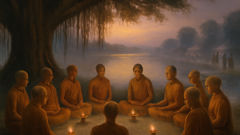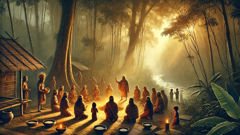Introduction
When the early morning mist lifts from the Ganges and the sun leans like a gold coin over the horizon, villages wake slowly: lamps gutter, fishermen mend nets, monks chant fragments of ancient syllables. In that hush between the world’s first breath and the day’s tasks, stories circulate—quiet as river reeds—about those who passed beyond desire yet chose, out of endless kindness, to remain within the swirl of life. They are called Arhats in many old languages: perfected ones, cleansed of craving and aversion, who have entered the stillness of nirvana but answered a deeper call to stand as shelter for others. These are not distant gods but figures who walked muddy paths, sat beneath banyan trees, argued with merchants and emperors, and touched the hands of the grieving. The legends that follow are stitched from such lives: individual episodes—sometimes improbable, sometimes painfully intimate—that linger because they show what wisdom looks like when rubbed against the ordinary. Each story is a small lantern, shaped by place and time: a monk who used a miracle as medicine, a saint who silenced a storm and redeemed a drowning town, a desert-seated ascetic whose refusal to yield became a refuge for those who would later teach. In the telling, these tales become both map and mirror. They point toward the quiet territory of insight and show us how compassion can wear many faces—stern and merciful, gentle and unyielding. Read these narratives as you might listen to an old traveler by the fire: without hurry, with the impulse to learn, and with readiness to be altered. For the Arhats’ stories are rooted in India’s soil and breath, yet their reach is wider: each one offers a way to understand how emancipation and engagement can, paradoxically, walk hand in hand.
Pindola and the Village of Borrowed Miracles
The story of Pindola begins in a small riverside hamlet, where everyone’s livelihood depended on the fickle moods of water. The river gave fish and took households when it rose without warning. Some nights the people would tie their mattresses to poles and drift downstream in small clusters, the moon their only compass. Pindola—whose name is said in many versions to mean something like "flower of the field"—arrived in such a place with only a robe, a simple bowl, and an unhurried step. He had been known among the traveling sangha as a man with unusual facility for demonstrating the Dharma’s power in visible forms: healing a blind child’s eye, stopping a fever with a touch, producing a bowl of rice when famine pressed hard. Yet he was also warned by elders and peers that demonstrations could become distractions, that the hungry eye would learn to clutch at wonder rather than to taste insight.

This village tested him. A monsoon had come late that year, and the river had somehow found new tricks—swelling overnight in the lull between storms and springing wild eddies. One evening, after a bartered meal and the soft singing of women mending nets, a boat overturned near the crossing. It took a child. The village surged into a panic: prayers, frantic plunges, and the lament of someone losing the future of their house. Pindola walked to the river’s edge. In the version elders pass along, he looked not at the water but at the people, and the people at him, and in that looking there was a kind of exchange: grief offered, steadiness returned. He waded in with a calm that seemed to realign the current around him. Hands reached, and the child was pulled out soaked, wide-eyed, and alive.
The miracle—if miracle it was—changed the village’s relationship to Pindola. Some called him a saint; others suspected trickery. Rumors traveled like birds: the Arhat had power to bend nature. Merchants sought favors; kings sent emissaries requesting tokens and omens. Pindola felt pressure. He understood that a single rescue had a cost: people might come to worship the marvel rather than to examine their own hearts. So he took a different approach. He taught the villagers to read the river: the smell of its breath, the angle of the reeds, the way fish jumped. He encouraged the carpenters to strengthen boats and the mothers to teach their children how to float. He showed how attention and technique could prevent many calamities more reliably than waiting for miracles.
One day a wealthy pilgrim visited and demanded that Pindola show a wonder to prove his credentials. The man had lost his only son to fever years before and wanted a demonstration of power that could bring him certainty. Pindola did not refuse outright. Instead, he invited the pilgrim to walk with him to the temple’s back porch, where a clay pot stood cracked but holding an inch of stagnant water. They sat. Pindola spoke of impermanence—the pot’s crack, the water’s restlessness, the pilgrim’s grief. He then took a small wooden spoon, scooped the water, and poured it into the man’s cupped hands. It was a simple act, utterly ordinary. As the cool water touched the pilgrim’s skin, his knotted fists eased. He wept, not from a conjured spectacle but from the long release of a man who found his tight belief less than his capacity to feel.
This, Pindola taught, was the truer miracle: a return of sensitivity to the living moment. If the villagers told the story in years to come, they kept the rescue at the river and the pilgrim’s release in the same breath, but the elders insisted that the rescue mattered less than the work of teaching people how to be rescued by their own skill and shared care. Pindola remained among them for seasons, not as an object of awe but as a teacher of practical compassion, modeling how insight and technique can coexist. That balance—of wonder and everyday skill—appears again and again in the Arhats’ tales: power used to loosen clinging, not to chain it anew.
What endures in the telling is not simply the event but its aftershape. The village rebuilt a higher quay. Parents built stepping-stones for children. When lightning struck five years later and the thatched roofs smoked, neighbors formed a chain and passed buckets like a practiced ritual. The villagers would say, half-proud and half-humored, that Pindola had given them a miracle and a lesson, and that the lesson had been the larger gift. In quiet months some young people would sit under the banyan and ask the elders what made a person choose to remain in the world after seeing the edge of nirvana. The elders would answer with a smile: because the world is not only a place of suffering; it is also the field where compassion takes root. And so Pindola, who had once performed marvels, was remembered most as a patient craftsman of communal habit and as a figure who understood that miracles cannot take the place of skillful tenderness.
Upagupta, the River-Ghost, and the Silent Town
Upagupta’s tale is told on long winter evenings around hearths where tea steams and histories lean toward myth. He is often depicted as a quiet man, strict in ascetic habit but capable of warmth so sudden it startled those who met him. In one legend, a town downstream from a temple lay in a strange paralysis: boats would be swept apart on glass-still days, fish would die without fever or rot, and a low wailing wind circled the marketplace at dusk. The elders began to speak of a river-ghost—a spirit offended by the way the town had begun to pile its dead outside the city gates and to toss refuse into tributaries. The river, in their retelling, was a living being whose appetite had been insulted by neglect and cruelty.

Upagupta arrived at that town with a staff, a bowl, and a reputation for stern mercy. He walked through the market and saw the signs: a child throwing bones to the dogs, a nobleman draining left-over oil into a drain that fed the stream, a potter hurling cracked vessels into a drainage. The town’s people, used to ritual as a convenience rather than practice, had grown careless. For the river to respond in such a way was not merely the whim of a spirit; the villagers had become a community that turned its face away from the web of relations. Upagupta convened a meeting in the temple courtyard and told them that if they wished the river to return to its old temper, they must first restore the natural courtesies: bury the dead with care, stop the thoughtless dumping, share food rather than hoard it.
They laughed him off at first. What did such austerity matter to merchants preoccupied with ledgers? But then a child disappeared in the market—a son of a weaver—and the jest turned into grief. The temple’s abbot urged Upagupta to perform a ritual to placate the river. What the abbot did not expect was the kind of ritual Upagupta offered. He took no incense bills, no gold. Instead he walked to the river at dawn, stripped his robes, and carried a basket of returned things: the potter’s broken shards he had gathered, the bones that the child had been throwing, the oil drained from the noble’s gutter, and the cloth a widow had discarded. He arranged them on the riverbank, then sat cross-legged facing the flowing water. Villagers gathered, whispering that such an act was sacrilege—the man was bringing filth to the river—but Upagupta’s stillness reframed everything. He spoke quietly into the breeze, not of curses and not of boasts, but of relationship.
When children pressed forward, Upagupta taught them to fish with nets that allowed small fry to escape, to leave part of the catch for the birds. He taught potters to mend what they could and to hand cracked wares to those who could turn them into grains bins rather than toss them away. He taught the nobleman to steward his oil, to collect and reuse. The gestures were small and practical, but they formed a new choreography. The river, so the story says, ceased pulling misfortune into the town because the town had stopped pushing harm into the river. The child was found days later, safe under a reedbed downstream, protected by a fisher who had learned the new habits and offered shelter.
Beyond the pragmatic, Upagupta’s story holds a different kind of claimer: he tamed a literal and figurative demon by restoring a community’s sense of reciprocity. The river demon in the tale is less an otherworldly monster and more an embodiment of consequences. Upagupta told the people: awaken your ordinary compassion and you silence the extraordinary threats. There is also a moment in the legend when a skeptical trader asks Upagupta why, after all his hospitality to the river and the town’s reforms, the storms of some seasons still took roofs. Upagupta answered that the world would never be perfectly safe; only the heart’s lit state of attention would change how suffering was borne and repaired. That is a lesson that hardened in their telling: the Arhat’s power is not a shield that wards off all harm but a capacity to stand steady so the community can respond with integrity.
Finally, in many versions, Upagupta refuses the town’s offer of tenure and permanence. Merchants build small shrines to him, saying he should accept a house. He declines. He says that to dwell too comfortably risks the dulling of vigilance. Instead he teaches a young apprentice chosen from the weavers to maintain the riverside vigil. Years later, that apprentice becomes the seed of a guild of stewards who nurture both water and people. In the long arc of Upagupta’s story, what matters is the passing on: the saint does not impose a rule but cultivates capacities in others—skills, habits, and moral attention—so that the town can steward itself. The miracle, if the villagers ever name it so, was not in silencing a spirit but in shifting the town’s habits until the river returned to its gracious, if sometimes wild, state.
Conclusion
Taken together, these tales of Pindola and Upagupta—like other Arhat stories—reveal a pattern: the saints’ power lies less in theatrical miracles than in the steady reconfiguration of human practice. Each legend tilts the reader’s understanding of spiritual authority away from spectacle and toward sustained care. To remain in the world after the attainment of nirvana is, in these myths, an act of humility as much as compassion. The Arhats did not become guardians by seizing power; they became anchors by cultivating presence, skill, and an insistence on practical kindness. They teach us that awakening is not an escape but a deeper form of engagement, a way of being that repairs nets and tends fires, a posture that invites communities to learn their own capacity for rescue and repair. In the end, these stories are less about perfected beings who fix everything and more about the friendships that form around shared responsibility: disciples and villagers, teachers and apprentices, the mundane and the numinous braided into a life that keeps being taught and retaught. If you carry one image from these pages, let it be this: a lantern passed from hand to hand on a rain-dark night, not as a spectacle but as a tool, steadying each person who holds it so they may see the next step.













